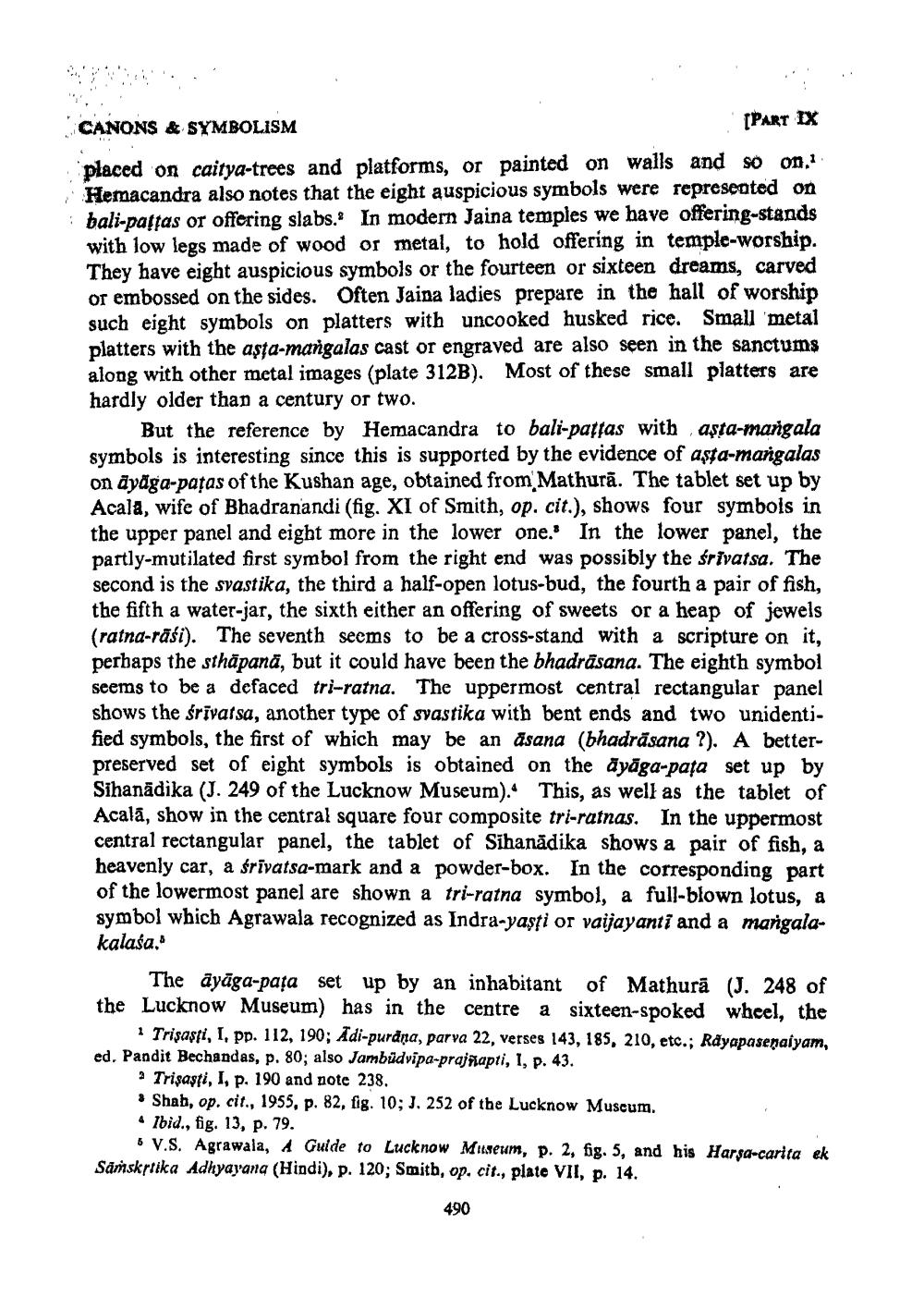________________
CANONS & SYMBOLISM
[PART IX placed on caitya-trees and platforms, or painted on walls and so on. Hemacandra also notes that the eight auspicious symbols were represented on bali-patsas or offering slabs.* In modern Jaina temples we have offering-stands with low legs made of wood or metal, to hold offering in temple-worship. They have eight auspicious symbols or the fourteen or sixteen dreams, carved or embossed on the sides. Often Jaina ladies prepare in the hall of worship such eight symbols on platters with uncooked husked rice. Small 'metal platters with the aşta-mangalas cast or engraved are also seen in the sanctums along with other metal images (plate 312B). Most of these small platters are hardly older than a century or two.
But the reference by Hemacandra to bali-paffas with aşta-mangala symbols is interesting since this is supported by the evidence of asta-mangalas on dyaga-patas of the Kushan age, obtained from Mathurā. The tablet set up by Acala, wife of Bhadranandi (fig. XI of Smith, op. cit.), shows four symbols in the upper panel and eight more in the lower one. In the lower panel, the partly-mutilated first symbol from the right end was possibly the śrivatsa. The second is the svastika, the third a half-open lotus-bud, the fourth a pair of fish, the fifth a water-jar, the sixth either an offering of sweets or a heap of jewels (ratna-rāśi). The seventh secms to be a cross-stand with a scripture on it, perhaps the sthāpanā, but it could have been the bhadrâsana. The eighth symbol seems to be a defaced tri-ratna. The uppermost central rectangular panel shows the śrivatsa, another type of svastika with bent ends and two unidentified symbols, the first of which may be an asana (bhadrāsana ?). A betterpreserved set of eight symbols is obtained on the dyāga-pata set up by Sihanādika (J. 249 of the Lucknow Museum). This, as well as the tablet of Acalā, show in the central square four composite tri-ratnas. In the uppermost central rectangular panel, the tablet of Sihanädika shows a pair of fish, a heavenly car, a srivatsa-mark and a powder-box. In the corresponding part of the lowermost panel are shown a tri-ratna symbol, a full-blown lotus, a symbol which Agrawala recognized as Indra-yaşti or vaijayanti and a mangalakalasa."
The ayāga-pața set up by an inhabitant of Mathurā (J. 248 of the Lucknow Museum) has in the centre a sixteen-spoked wheel, the
Trişasti, I, pp. 112, 190; Adi-purana, parva 22, verses 143, 185, 210, etc.; Rayapasenasyam, ed, Pandit Bechandas, p. 80; also Jambūdvipa-prajslapti, I, p. 43.
Trisasti, I, p. 190 and note 238. * Shah, op. cit., 1955, p. 82, fig. 10; J. 252 of the Lucknow Muscum. * Ibid., fig. 13, p. 79.
6 V.S. Agrawala, A Guide to Lucknow Museum, p. 2, fig. 5, and his Harga-carita ek Sāńskrtika Adhyayang (Hindi), p. 120; Smith, op. cit., plate VII, p. 14.
490




